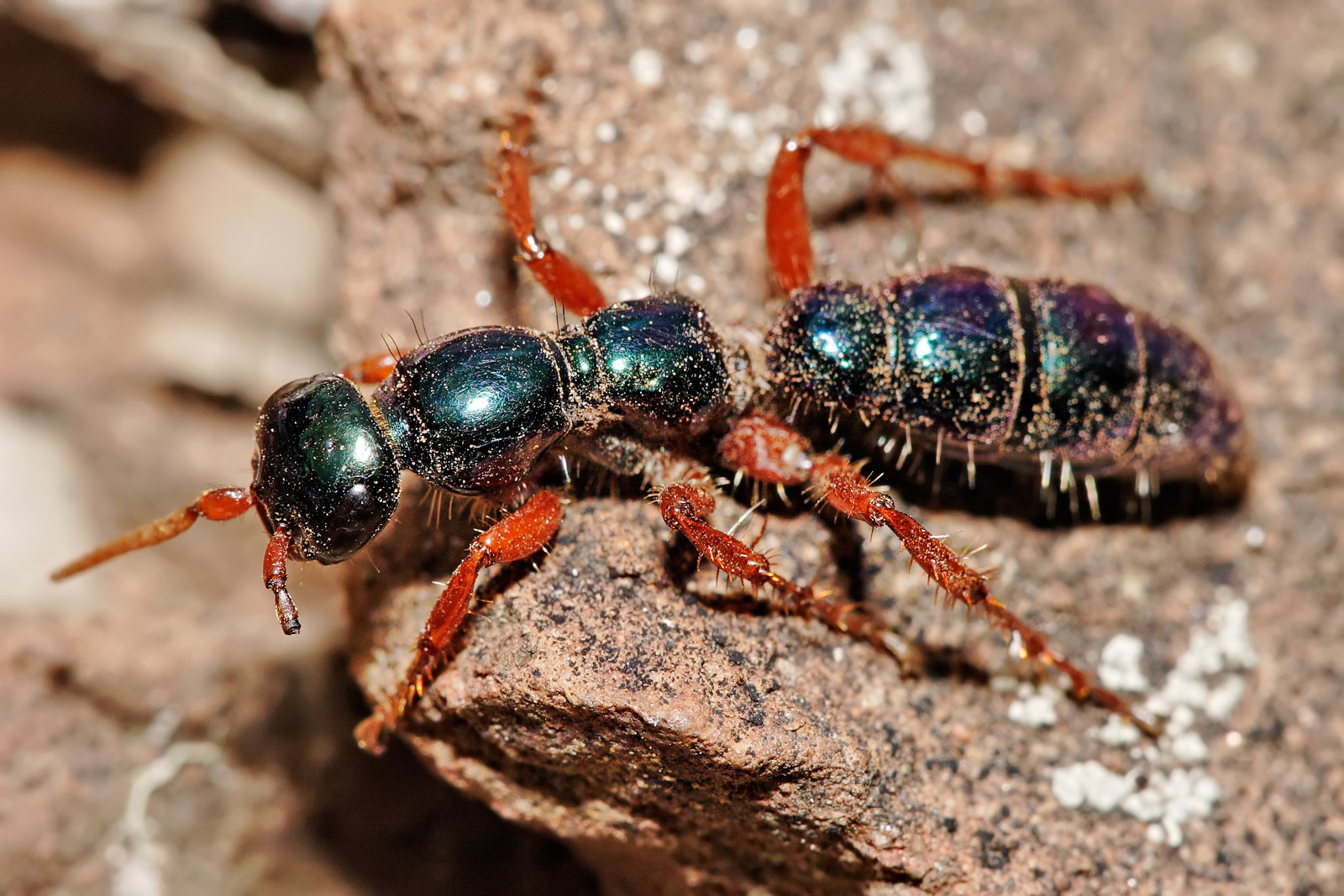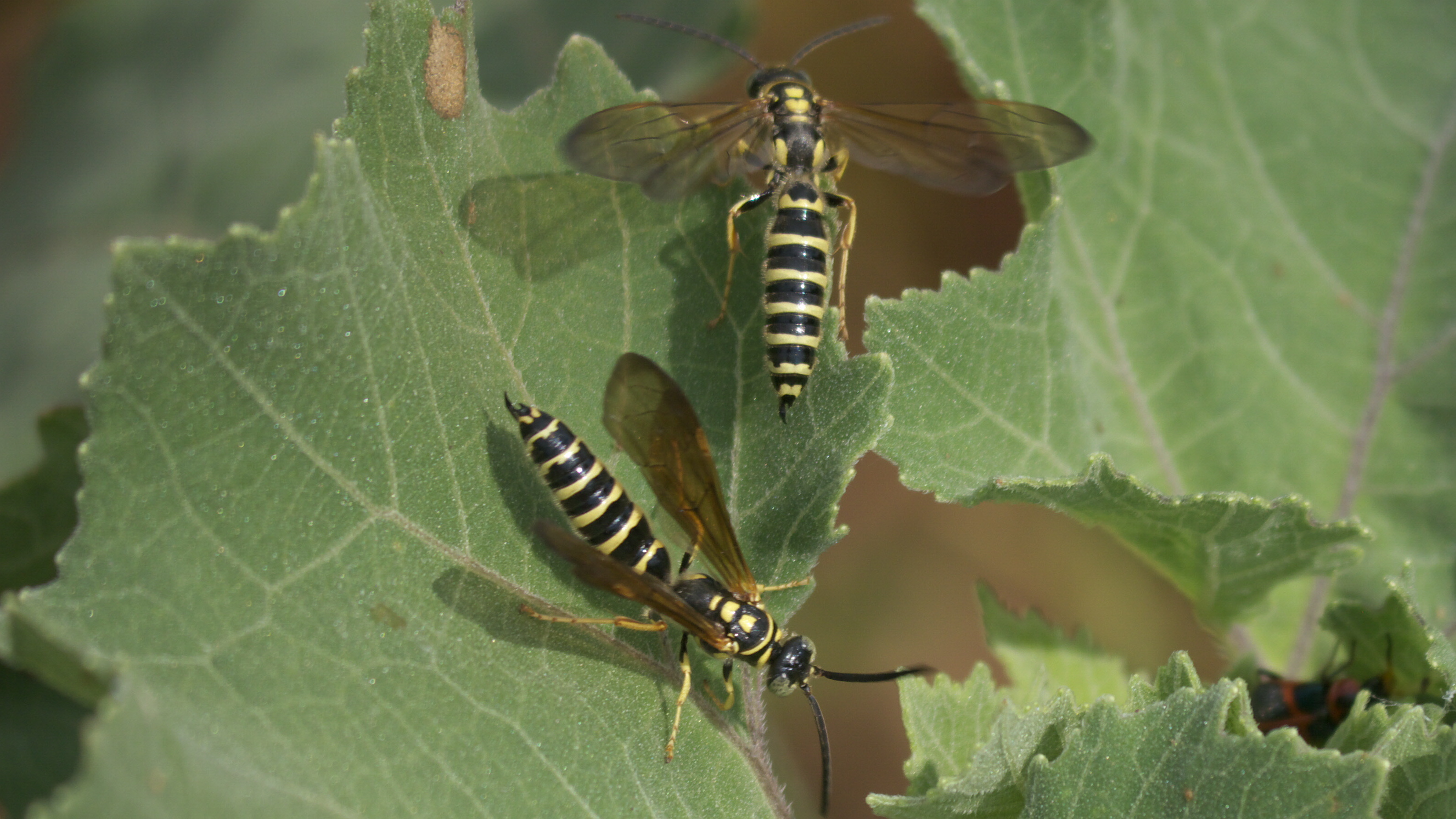|
Thynnidae
The Thynnidae (also known as thynnid wasps or flower wasps) are a family of large, solitary wasps whose larvae are almost universally parasitoids of various beetle larvae, especially those in the superfamily Scarabaeoidea. Until recently, the constituents of this family were classified in the family Tiphiidae, but multiple studies have independently confirmed that thynnids are a separate lineage. Description Most species are small, but they can be up to 30 mm long. The females of some subfamilies (all Diamminae, Methochinae, and Thynninae) are wingless, and hunt ground-dwelling (fossorial) beetle larvae, or (in one species) mole crickets. The prey is paralysed with the female's sting, and an egg is laid on it so the wasp larva has a ready supply of food. In species where both sexes are winged, males are similar in size to the females, but are much more slender. The males of species with wingless females, however, are often much larger than the females and have wings; the ... [...More Info...] [...Related Items...] OR: [Wikipedia] [Google] [Baidu] |
Agriomyia
''Agriomyia'' is a genus of wasps in the family Thynnidae The Thynnidae (also known as thynnid wasps or flower wasps) are a family of large, solitary wasps whose larvae are almost universally parasitoids of various beetle larvae, especially those in the superfamily Scarabaeoidea. Until recently, the co .... References Thynnidae Hymenoptera genera {{apocrita-stub ... [...More Info...] [...Related Items...] OR: [Wikipedia] [Google] [Baidu] |
Methochinae
Methochinae is a small subfamily of solitary wasps in the family Thynnidae, whose larvae are parasitoids of various tiger beetle larvae. Genera * ''Methocha ''Methocha'' is a genus of parasitoid wasps in the family Thynnidae. The species of this genus are found worldwide except in Australia, and attack the larvae of tiger beetles. Females are wingless, and can be mistaken for ants, while males are w ...'' Latreille, 1804 * '' Pterombrus'' Smith, 1869 References {{apocrita-stub ... [...More Info...] [...Related Items...] OR: [Wikipedia] [Google] [Baidu] |
Myzinum Quinquecinctum P1240895a
''Myzinum'' is a genus of wasps in the family Thynnidae. There are 63 species presently recognized in ''Myzinum''.Kimsey, L. (2009) Taxonomic purgatory: Sorting out the wasp genus ''Myzinum'' Latreille in North America (Hymenoptera, Tiphiidae, Myzininae). Zootaxa 2224: 30-50. doi: 10.5281/zenodo.190193 They measure 7–24 mm. Found in New World, ''Myzinum'' wasps are most diverse in the Neotropics. They are found in meadows, fields, and lawns. They parasitize white grubs (scarab larvae), especially '' Phyllophaga''. They are used as biological controls. Selected Species * ''Myzinum carolinianum'' Panzer * ''Myzinum frontale'' Cresson * ''Myzinum fulviceps'' Cameron * ''Myzinum maculatum'' (Fabricius, 1793) * ''Myzinum navajo'' Krombein * ''Myzinum obscurum'' (Fabricius, 1805) * ''Myzinum quinquecinctum ''Myzinum quinquecinctum'', the five-banded thynnid wasp, is a species of thynnid wasp in the family Thynnidae, found mainly in North America east of the Rocky Mountains. Re ... [...More Info...] [...Related Items...] OR: [Wikipedia] [Google] [Baidu] |
Tiphiidae
The Tiphiidae (also known as the tiphiid wasps) are a family of large, solitary wasps whose larvae are parasitoids of various beetle larvae, especially those in the superfamily Scarabaeoidea. Until recently, this family contained several additional subfamilies, but multiple studies have independently confirmed that these comprise a separate lineage, and are now classified in the family Thynnidae. The females of some Brachycistidinae are wingless, and hunt ground-dwelling ( fossorial) beetle larvae. The prey is paralysed with the female's sting, and an egg is lain on it so the wasp larva has a ready supply of food. As some of the ground-dwelling scarab species attacked by tiphiids are pests, some of these wasps are considered beneficial as biological control agents. Taxonomy Tiphiid genera are classified as follows: Subfamily Brachycistidinae *'' Acanthetropis'' Wasbauer, 1958 *'' Brachycistellus'' Baker, 1907 *'' Brachycistina'' Malloch, 1926 *'' Brachycistis'' Fox, 1 ... [...More Info...] [...Related Items...] OR: [Wikipedia] [Google] [Baidu] |
Diamminae
The blue ant (''Diamma bicolor''), also known as the blue-ant or bluebottle, despite its name and appearance, is not an ant, but rather a species of large, solitary, parasitic wasp sometimes known as a flower wasp. It is native to south and southeast Australia, including the states of Tasmania, New South Wales, Victoria, and South Australia. It is the sole member of the subfamily Diamminae and the genus ''Diamma'', and is both morphologically and behaviorally unusual among members of the family Tiphiidae. Blue ants have a distinctive metallic blue-green body, with red legs. The female ranges up to in length, is wingless and ground-dwelling, and exclusively hunts mole crickets, whereas all other species of tiphiids attack beetle larvae. The cricket is paralysed with venom injected by the female's stinger and an egg is laid upon it so the wasp larva has a ready supply of food. The male is smaller, about , and has wings. Adults feed on nectar and pollinate various native Austral ... [...More Info...] [...Related Items...] OR: [Wikipedia] [Google] [Baidu] |
Methocha
''Methocha'' is a genus of parasitoid wasps in the family Thynnidae. The species of this genus are found worldwide except in Australia, and attack the larvae of tiger beetles. Females are wingless, and can be mistaken for ants, while males are winged. Biology Female ''Methocha'' actively hunt over the ground for burrows containing tiger beetle larvae, which are ambush predators; the wasp entices the beetle larva into attacking, evades being bitten, and quickly moves in and stings the larva in its vulnerable underside, paralyzing it. It then lays an egg on the immobile beetle larva, and the wasp larva consumes it.E.O. Wilson, D.J. Farish (1973) Predatory behaviour in the ant-like wasp ''Methocha stygia'' (Say) (Hymenoptera: Tiphiidae). ''Animal Behaviour'' 21(2):292-295. DOI:10.1016/S0003-3472(73)80069-7 Species * ''Methocha alutacea'' Linnaeus * ''Methocha anomala'' Krombein * ''Methocha californica'' Westwood, 1881 * ''Methocha formosa'' Krombein, 1954 * ''Methocha ichneumo ... [...More Info...] [...Related Items...] OR: [Wikipedia] [Google] [Baidu] |

